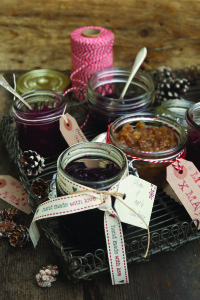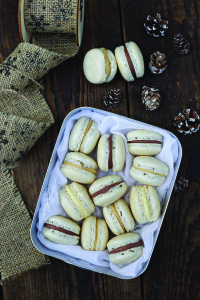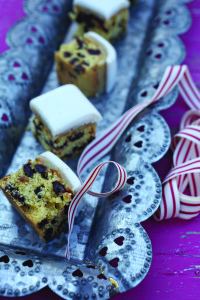With only one and a half weeks to go to Christmas, this week I am devoting my column to edible gifts, there are a zillion delicious suggestions I could make, and you too can have fun in the kitchen, so why not decide to have a cooking party with a couple of pals.
Many people like to cook alone in the peace and quiet (if there is such a thing) of their own kitchen, others love the buzz of cooking with kids and teenagers and don’t bother about the mess. After all, these fun session are what memories are made of.
Really good homemade jams and chutneys are always welcome, but we also love relishes and perky sauces. Moroccan tomato jam and confiture d’oignons or onion marmalade or beetroot and ginger relish will do so much to perk up cold cuts and chunky sandwiches around Christmas, and you’ll find your friends sidling up to you, begging for more. The beetroot relish is also delicious with goats cheeses and makes a tasty topping for canapés, it’s also a winner as a simple starter paired with crusty bread and a few fresh rocket leaves.
Rolls of fridge or freezer cookie dough or Doune McKenzie’s cheese biscuits, buttery short crust or puff pastry are terrific little treasures to have in your fridge. The latter can be used to top a pie or to whizz up a comforting apple tart. Cookie dough keeps well in a fridge or freezer. Pop a few slices of cookies dough into the oven, and what’s not love about cookie dough – the eternal standby. The Doune McKenzie’s cheese biscuits use up scraps of slightly dry cheese in the most delicious way.
If you make sloe or damson gin earlier in the autumn now is the time to transfer it into those cute little stoppered bottles. Sloe gin and tonic is delicious to sip with a slice of Christmas cake.
There’s a whole chapter in my revised edition of Simply Delicious Christmas on edible presents.
Pear and cranberry, blood plum and apple or banana and date chutney, pickled pears – these are quick and easy condiments to rustle up. Pop them into quirky small jars, dress them up with fun labels and make up some home-made Christmas hampers.
How about marshmallows or nougat, the recipe makes a million! Snowballs dusted in icing sugar also make an irresistible gift as do frosted candied peel, home-made macaroons and how about festive chocolate pops or melt in the mouth chocolate truffles. I won’t go on – a reader just texted me to say the new Simply Delicious Christmas was worth the price of the book just for the Edible Presents chapter alone – fancy that!
Moroccan Tomato Jam
A high percentage of cinnamon is in fact cassia, so seek out cinnamon from Sri Lanka or Ceylon. I first came across this delicious jam when I visited a Berber family in the Atlas Mountains in the 1980’s – delicious with cold meats, cheese, crostini……
Makes 6 x 200ml (7fl oz/scant 1 cup) jars
4 tablespoons (5 American tablespoons) extra virgin olive oil
110g (4oz) chopped onion
salt and freshly ground pepper
2.2kg (5lb) very ripe tomatoes, peeled and chopped
1-2 teaspoons Sri Lankan cinnamon (careful might be too much)
4 tablespoons (5 American tablespoons) chopped coriander
2 tablespoons (2 1/2 American tablespoons) tomato purée
4-6 (5 – 7 1/2 American tablespoons) tablespoons honey
Heat the olive oil in a wide heavy-bottomed stainless steel saucepan or sauté pan, add the chopped onion. Season with salt and freshly ground pepper and cook on a gentle heat for a couple of minutes, while you peel and chop the tomatoes. Add the tomato purée to the onions with the tomatoes, 1 teaspoon cinnamon and 3 tablespoons (4 American tablespoons) of the freshly chopped coriander. Cook uncovered until the tomato is thick and concentrated, approx. 30 minutes. Stir occasionally, otherwise it will catch on the bottom.
It will be thick and jam like, stir in another teaspoon of cinnamon, the remaining coriander and the honey. This is meant to be sweet, but reduce honey if you rather it less intense.
Cook, taste and tweak the seasoning if necessary.
Beetroot and Ginger Relish
This recipe was also published in my ‘Forgotten Skills’ book but I couldn’t omit it from this book because it’s so good with cold meats, coarse country terrines, pickled ox tongue, goats’ cheese … Another great presie and a contender for a Christmas hamper.
Makes 4 jars (yields 500ml approximately)
Serves 8 – 20 depending on how it’s served
225g (8oz) onion, chopped
45g (1½ oz) butter
3 tablespoons sugar
salt and freshly ground pepper
450g (1 lb) raw beetroot, peeled and grated
2 teaspoons grated fresh ginger
25ml (1fl oz) sherry vinegar
120ml (4fl oz) red wine
Sweat the onions slowly in butter, they should be very soft, add sugar and seasoning. Add the rest of the ingredients and cook gently for 30 minutes. Serve cold.
This relish keeps for ages.
Pear and Cranberry Chutney
Everyone loves this, its quick to rustle up, makes great presents, and is of course, delicious served with cold meat, cheese, and slathered onto crostini.
Makes 8 x 200ml (7fl.oz) jars
350g (12oz) cranberries
900g (2lb) pears (6 pears approx.. depending on size) peeled, quartered, cored and cut into 1cm (½ inch) dice
450g (1lb) sugar
225ml (8fl oz) cider vinegar or white wine vinegar
1 x 5cm (2 inch) piece fresh ginger, peeled and grated – 35g (1½oz)
1 x 10cm (4 inch) cinnamon stick
1 clove
100g (3 ½oz) raisins
Put the pears, cranberries, sugar, vinegar, and ginger into a large saucepan. Tie the cinnamon stick and clove in a square of cheesecloth and add to saucepan. Bring to the boil over a medium heat. Simmer uncovered until the cranberries collapse and the pears are tender, 15 to 20 minutes.
Stir the raisins into the chutney and cook for 25 minutes. Remove from the heat. When cool, remove cheesecloth bag. Refrigerate in a covered container or pot into 6 sterilized jars.
Serve with cold meats.
Blood Plum and Apple Chutney
Another favourite which ticks all the boxes.  Try it with Duck, Goose or Pork.
Makes 7 x 200ml (7fl oz) small jars
110ml (4 fl ozs) cider or wine vinegar
175g (6ozs) caster sugar
1 cinnamon stick
2 star anise
1/2 teaspoon peeled and grated ginger
900g (2lb) blood red plums, stoned and chopped
900g (2lb) Bramley apples, peeled and chopped
Put the vinegar and sugar in a stainless steel saucepan with the cinnamon, star anise and ginger. Heat and stir until the sugar dissolves. Add the chopped plums and apples, simmer gently for about 40 minutes until the plums and apples are tender and the liquid is thick. Pour into jars. Cover and keep in the fridge.
Â
Fridge or Freezer Cookies
Particularly good with coffee. A crisp, rich biscuit. The mixture can be kept in the fridge for several days or popped in the freezer.
Makes 50 approximately
200g (7oz) butter
150g (5oz) caster sugar
225g (8oz) self-raising flour
1 large organic egg
75g (3oz) shelled walnuts, pecans or hazelnuts, chopped
Cream the butter and sugar, then add the flour, beaten egg and chopped nuts. Shape the dough into a long roll or rolls, about 5cm (2 inches), in diameter, or smaller if you prefer, and wrap in silicone paper or foil. Chill in the refrigerator until the next day.
Preheat the oven to 190ºC/375ºF/Gas Mark 5.
Cut the dough into very thin rounds. Arrange well apart on a baking tray. Cook them for 10 minutes in the preheated oven, they should remain pale in colour. Transfer to a wire rack.
Doune McKenzie’s Cheese Biscuits
This is a brilliant recipe for using up leftover cheese. A little soft cheese may also be added, but you will need to balance the flavour with hard cheese. Delicious to nibble with a glass of wine or to tuck into a lunch box.
Cheddar, Parmesan, Gruyère or other cheese of your choice
butter
plain white flour
Weigh the cheese, then use the same weight of butter and flour. Preheat the oven to 250ºC/475ºF/gas mark 9.
Grate the cheese – rinds and all. Dice, then cream the butter. Stir in the flour and grated cheese and form into a roll like a long sausage, about 4cm (11â„2in) thick. Alternatively whizz in a food-processor until it forms a dough – shape using a little flour if necessary. Chill in the refrigerator for 1–2 hours, until solid.
Slice into rounds about 7mm (1â„3 in) thick. Arrange on a baking tray and bake for about 5 minutes or until golden. Leave to cool for a couple of seconds, then transfer to a wire rack. These biscuits are best eaten on the day they are made as they soften quite quickly.
Pat Browne’s Almond Macaroons
We’ve got lots of macaroon recipes, but this one given to us by one of our tutors Pat Browne, is the most foolproof of all. They can be flavoured or coloured as you wish, a few drops of rosewater or orange blossom water, a little crème de menthe……
Makes 74 approx of petit four size
4 free range organic egg whites, depending on size
25g (1oz) caster sugar
225g (8oz) icing sugar
115g (4¼oz) ground almonds
Baking tray or trays
No 9 plain piping nozzle
Preheat the oven to 140°C/275°F/Gas Mark 1
Cover the baking tray with parchment paper or a Silpat mat.
Whisk the egg whites and castor sugar until stiff.
Sieve the icing sugar twice into a bowl. Add the ground almonds to the icing sugar.
Mix half the dry ingredients into the egg whites and then fold in the remainder.
Pipe into approx. 2.5cm (1 inch) rounds onto a baking tray.  Rest for 30 minutes, then bake in the preheated oven for 12-14 minutes until pale golden. Continue to cook the remainder.
The macaroons are cooked when they lift easily off the paper.
Cool on a wire rack and store in an airtight tin.
Sandwich together with chocolate, lemon or coffee butter cream.
Chocolate Butter Cream
110g (4oz) soft butter
225g (8oz) icing sugar, sieved
1 level tablespoon cocoa powder, sieved
1 dessertspoon hot water
Cream the butter and add the sieved icing sugar. Mix the cocoa powder with the hot water and beat into the mixture until light and fluffy.
Lemon Butter Cream
110g (4oz) soft butter
225g (8oz) icing sugar, sieved
Finely grated rind of ½ lemon
Cream the butter and add the sieved icing sugar and lemon zest. Beat until light and fluffy.
Â
Coffee Butter Cream
110g (4oz) butter
225g (8oz) icing sugar, sieved
2-4 teaspoons Irel or Camp coffee essence
Whisk the butter with the sieved icing sugar and add the coffee essence. Continue to whisk until light and fluffy.
Festive Chocolate Pops
225g (8oz) dark or white chocolate, chopped
Chocolate Pop moulds
Put the chocolate into a Pyrex bowl over a saucepan of hot water (the base of the bowl should not touch the water). When the water comes to the boil, turn off the heat and leave until the chocolate melts.
Melt the white or dark chocolate as above, spoon into the moulds. Insert a lollipop stick.
Tap the work top to smooth over the top.
Decorate the top with freeze-dried raspberries or dried cranberries or Santas…
Allow to set. Unmould.
Serve in a piece of oasis decorated with holly or coloured tissue etc.
Hot Tips
Wilson on Wine 2015.   I’ve just come across John Wilson’s (one of Ireland’s more iconic wine writers) new wine book ‘Wilson on Wine 2015’. It features John’s favourite wines & what a list….it could be the ideal stocking filler for the wine lover in your life. Signed copies are available in Bradley’s Off Licence, Cork and The Ballymaloe Shop.
Helen James at Dunnes Stores.  A few weeks ago, I got a gorgeous hamper choc-a-bloc with ‘artisan food’ products and housewares from Helen James. This talented designer has teamed up with Dunnes Stores to create a new range entitled ‘Considered’. Check it out it’s exceptionally good quality. Paul Costelloe’s range is not to be missed either and congratulations to Dunnes Stores for creating these visionary partnerships.
Ballymaloe Pop Up wine shop. Award winning sommelier Colm McCan has amassed a tempting selection of wines for Christmas (including some organic, biodynamic and natural wines) from the award winning wine cellar at Ballymaloe. Open weekends at Ballymaloe House, beside the Grainstore on Saturday 11pm -4pm and Sunday 12.30pm – 4pm. Tel 021 4652531 res@ballymaloe.ie





